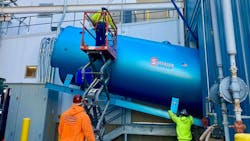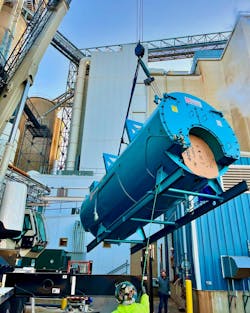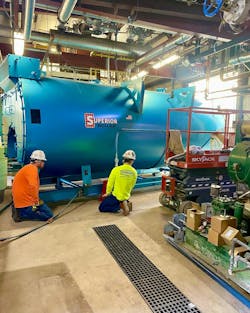Tight-Space Boiler Retrofit Delivers Big Efficiency Wins for Grain Millers
ST. ANSGAR, IOWA — Grain Millers, Inc., a trusted ingredient partner that specialized in providing high-quality grains and food ingredients—which focuses on sustainable practices from food to table—recently underwent a major boiler upgrade to enhance its operational efficiency and energy management.
Necessary to clear space for new, more efficient equipment, Rasmussen Mechanical Services, Council Bluffs, Iowa, was called in to replace an existing boiler with a larger capacity to facilitate increased steam demand, more specifically, providing total building heat and facilitating process steam used in oatmeal manufacturing. The project consisted of the removal of an outdated 150HP boiler, an existing deaerator and two air compressors and replacing it with a 300HP Superior 3-pass wetback boiler.
Carefully integrated into the existing infrastructure, a Limpsfield LC series burner, Autoflame Mk8 combustion controls, a Heatmizer FGL series condensing economizer, a Marlo RO system, a Rupp Air Makeup Air Unit, and an industrial steam deaerator were also added. Extensive piping labor and control wiring were performed to connect all components seamlessly.
Evaluation & Upgrade
“We ended up evaluating the system and upgrading several other parts of the system including the water treatment system, feedwater system, steam header piping, etc.,” says Shain Hunter, Industrial Sales (Steam Systems), Rasmussen. “We also added several energy conservation measures to ensure the system is operating as efficient as possible,” continues Hunter.
Some of those interesting efficiency features on the new system include the Heatmizer heat recovery system, which transfers waste heat from boiler exhaust gases and uses that energy to preheat the boiler feedwater. The effect is a decrease in fuel energy consumption for a given steam demand so you see maximum annual savings.
In addition, the Limpsfield LC series burners are a premix style burner where all the fuel and air are mixed prior to leaving the blast tube. This allows them to achieve low excess air figures and have efficient combustion. The team pounds and installs a refractory cone for the burner, ensuring proper heat containment. In other words, “the refractory cones on the Limpsfield burners have a flat profile and are pounded with ‘poundable refractory’ versus other cones that utilize a tapered profile and are poured into a form with castable refractory. After the cone is pounded, a bakeout procedure is performed to cure the refractory,” says Hunter.
Challenges Overcome
At the Grain Millers boiler upgrade, the Rasmussen team consisted of 20 members involved on the project, which included mechanical engineers, drafting personnel, a project manager, the mechanical construction crew, the industrial burner crew, and HVAC crew. While there were some challenges, none of them were anything Rasmussen couldn’t handle.
The biggest challenge with the project was the space constraints with which the Rasmussen crew had to work. “Everything in the boiler room is fairly tight so setting all the equipment was definitely a challenge. When rigging the boiler through the main door of the boiler room, we only had a couple inches of clearance on each side of the vessel,” says Hunter.
Another installation challenge was that the plant wasn’t able to shut down for more than two days. Rasmussen had a two-day shutdown that consisted of a 10-man day crew and six-man night crew that were able to cut in tees and valve off connections to each part of the system such as steam, condensate, feedwater, makeup water, and natural gas. “This allowed us to startup the new system and shutoff the old system without needing to have any additional shutdowns,” says Hunter.
Efficiency, Reliability, Compliance
Moving forward, Grain Millers Inc.’s new setup is more than capable of meeting current operational needs by improving energy efficiency, reliability and compliance with safety standards, and the company now has a modern, efficient boiler system that will support its production processes for years to come. This project underscores the importance of regular infrastructure upgrades in maintaining operational excellence and energy sustainability.



